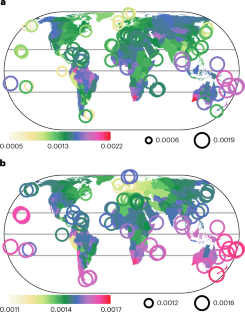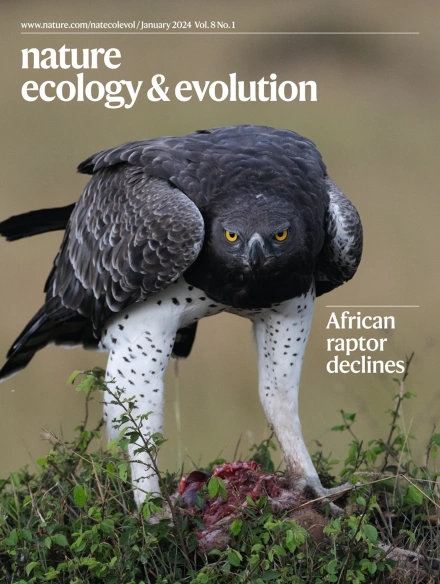环境过滤,而不是扩散历史,解释了种子植物在深层进化时间尺度上的系统发生转换的全球模式
IF 13.9
1区 生物学
Q1 ECOLOGY
引用次数: 0
摘要
环境过滤和扩散历史限制了植物的分布并影响了生物地理模式,但它们在进化时间尺度上的相对重要性是如何变化的还没有解决。系统发育多样性量化了组合之间进化相关性的差异性,可能有助于解决构成生物多样性的生态和生物地理机制。本文研究了环境差异和地理距离对全球27万种种子植物系统发育和分类更替的影响。我们利用古地理重建计算了过去和现在的扩散障碍,并计算了地理线性和最小成本距离,考虑了在水、山或气候不适宜的地区的扩散。环境差异和地理距离共同解释了大部分的分类变异(86.4%)和系统发生变异(65.6%)。虽然环境差异一直表现出强烈的积极影响,但地理距离对系统发生转换的影响在进化时间的进一步回溯中并不明显。过去的自然地理障碍解释了所有时间尺度上相对较低的变化,在中间时间尺度(20-50毫瓦bp)有一个轻微的峰值。我们的研究结果表明,虽然古老的谱系通常广泛分散,但环境过滤对范围扩展的影响仍然存在,这为了解全球生物多样性模式背后的生物地理和进化过程提供了见解。本文章由计算机程序翻译,如有差异,请以英文原文为准。


Environmental filtering, not dispersal history, explains global patterns of phylogenetic turnover in seed plants at deep evolutionary timescales
Environmental filtering and dispersal history limit plant distributions and affect biogeographical patterns, but how their relative importance varies across evolutionary timescales is unresolved. Phylogenetic beta diversity quantifies dissimilarity in evolutionary relatedness among assemblages and might help resolve the ecological and biogeographical mechanisms structuring biodiversity. Here, we examined the effects of environmental dissimilarity and geographical distance on phylogenetic and taxonomic turnover for ~270,000 seed plant species globally and across evolutionary timescales. We calculated past and present dispersal barriers using palaeogeographical reconstructions and calculated geographical linear and least-cost distances, accounting for dispersal over water, mountains or areas with unsuitable climates. Environmental dissimilarity and geographical distance jointly explained most of the deviance in taxonomic (up to 86.4%) and phylogenetic turnover (65.6%). While environmental dissimilarity consistently showed strongly positive effects, the effect of geographical distance on phylogenetic turnover was less pronounced further back in evolutionary time. Past physiogeographical barriers explained a relatively low amount of the variation across all timescales, with a slight peak at intermediate timescales (20–50 Myr bp). Our results suggest that while old lineages have generally dispersed widely, the imprint of environmental filtering on range expansion persists, providing insights into biogeographical and evolutionary processes underlying global biodiversity patterns. This modelling study integrates comprehensive regional plant inventories, environmental conditions and palaeogeographical reconstructions to assess the relative roles of environmental filtering and dispersal barriers in shaping global seed plant diversity, demonstrating that environmental filtering has a persistent effect on species distribution patterns across evolutionary timescales.
求助全文
通过发布文献求助,成功后即可免费获取论文全文。
去求助
来源期刊

Nature ecology & evolution
Agricultural and Biological Sciences-Ecology, Evolution, Behavior and Systematics
CiteScore
22.20
自引率
2.40%
发文量
282
期刊介绍:
Nature Ecology & Evolution is interested in the full spectrum of ecological and evolutionary biology, encompassing approaches at the molecular, organismal, population, community and ecosystem levels, as well as relevant parts of the social sciences. Nature Ecology & Evolution provides a place where all researchers and policymakers interested in all aspects of life's diversity can come together to learn about the most accomplished and significant advances in the field and to discuss topical issues. An online-only monthly journal, our broad scope ensures that the research published reaches the widest possible audience of scientists.
 求助内容:
求助内容: 应助结果提醒方式:
应助结果提醒方式:


